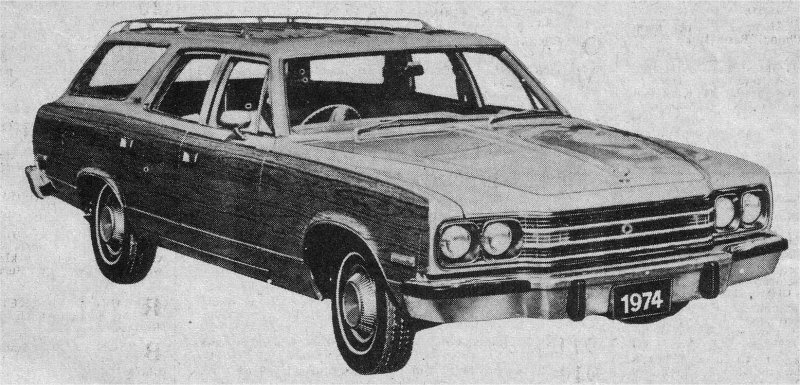The American automotive landscape of 1974 witnessed the sunset of an era as AMC prepared to retire its prestigious Ambassador line. The Station Wagon variant represented the pinnacle of American Motors’ full-size offerings, combining luxury with utility in a way that defined the American family car experience of the 1970s.
The final year of Ambassador production marked both an end and a celebration. AMC packed their flagship wagon with every conceivable luxury feature, creating a vehicle that stood shoulder-to-shoulder with contemporary offerings from the Big Three automakers.
Power and Performance
The 1974 Ambassador Station Wagon came exclusively with V8 power, reflecting its position as AMC’s premium offering. Three robust engine options catered to different needs: a 304 cubic inch (5.0L) base V8, a middle-range 360 cubic inch (5.9L) powerplant, and the mighty 401 cubic inch (6.6L) V8 producing 235 horsepower and 454 Nm of torque.
The Torque Command automatic transmission managed power delivery with remarkable smoothness for its time. This three-speed unit proved particularly well-suited to the wagon’s character, offering effortless cruising ability.
Fact!
The 401 V8 engine in the 1974 Ambassador was the largest engine ever offered in an AMC passenger car, making it a sought-after option among collectors today.
David Thompson, Classic AMC Restorer: «The ’74 Ambassador wagon with the 401 V8 was a beast. I’ve restored three of them, and each time I’m amazed by how well these engines were built. They’re incredibly robust and, when properly maintained, can easily clock over 200,000 miles.»
The rear-wheel-drive layout and robust chassis design provided stable handling characteristics despite the wagon’s substantial dimensions. Engineers achieved a commendable balance between comfort and control.
Dimensions and Practicality
The Ambassador Station Wagon impressed with its generous proportions:
- wheelbase stretching 122 inches (309.9 cm);
- overall length reaching 218.9 inches (556.0 cm);
- width measuring 77.28 inches (196.3 cm);
- height standing at 56.69 inches (144.0 cm).
These dimensions translated into exceptional interior space, making the Ambassador a genuine eight-passenger carrier. The flat cargo floor and wide-opening tailgate facilitated easy loading.
Sarah Miller, Automotive Historian: «What made the ’74 Ambassador wagon special was its attention to passenger comfort. While competitors focused on raw cargo space, AMC created a true premium family vehicle with thoughtful details like extra sound insulation and plush seating.»
Luxury and Equipment
The 1974 model year Ambassador showcased AMC’s commitment to luxury, offering an impressive array of standard features. Air conditioning, power steering, and front disc brakes came included, setting a new standard for family wagons.
Important!
Every 1974 Ambassador Station Wagon came standard with automatic transmission, power steering, and air conditioning - features that were still optional on many competing models at the time.
Interior appointments reflected the premium positioning, with high-quality materials and attention to detail. The Brougham trim level added extra touches of luxury, including upgraded upholstery and additional sound insulation.
Premium audio options, improved climate control systems, and various decorative elements allowed buyers to customize their wagons to taste. The extensive options list meant that no two Ambassadors were quite alike.
The Legacy Lives On
The 1974 Ambassador Station Wagon represented more than just the end of a model line. It embodied AMC’s ability to compete with larger manufacturers in the premium segment, offering a unique combination of luxury, practicality, and performance.
These wagons left an indelible mark on American automotive history, showcasing AMC’s engineering prowess and commitment to innovation. Today, surviving examples serve as rolling testaments to a time when American wagons ruled the suburbs.
Pros and Cons
| Advantages | Disadvantages |
|---|---|
| Powerful V8 engine lineup with three displacement options | Relatively high fuel consumption, especially with the 401 V8 |
| Comprehensive standard equipment package including air conditioning | Limited production numbers make parts increasingly scarce |
| Spacious interior with genuine eight-passenger capacity | Size can make parking challenging in modern settings |
| High build quality with robust mechanical components | Complex vacuum-operated systems can be difficult to maintain |
| Premium interior materials and comfort features | Weight impacts acceleration and handling compared to smaller vehicles |
| Excellent towing capability with the larger V8 options | Original trim pieces and interior materials are hard to source |
| Strong chassis design with good durability | Rust protection was adequate but not exceptional for the era |
The 1974 AMC Ambassador Station Wagon stands as a remarkable example of American automotive engineering from the 1970s. While it may not match modern vehicles in efficiency or technology, it offers a unique blend of luxury, practicality, and performance that continues to captivate enthusiasts. Its position as the last Ambassador wagon produced makes it particularly significant for collectors and AMC aficionados. Despite some inherent challenges of maintaining a classic vehicle, the Ambassador’s strengths far outweigh its limitations for those seeking a distinctive piece of automotive history.

